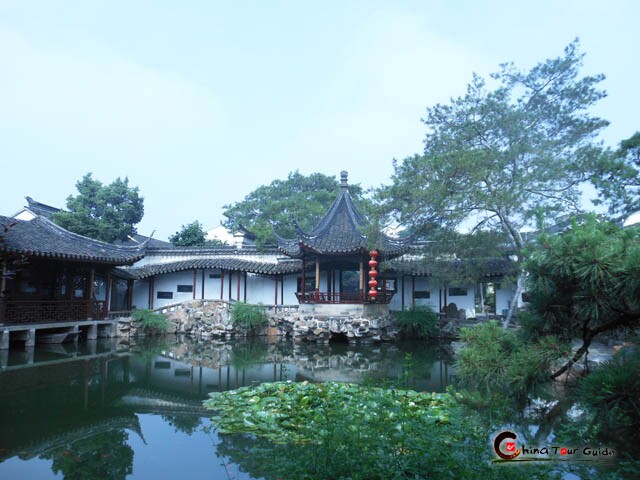Local Suzhou Tours
Master of the Nets Garden
Master of the Nets Garden is the smallest classic garden among Suzhou gardens, yet it is a most impressive one because of its use of space which creates the illusion of an area that is much greater than its actual size. Even more impressive than the architectural achievement is the mood of tranquility and harmony that this delicate garden embodies.
 |
 |
| The pond reflection | Arrangement that makes the garden look much bigger |
The Master of the Nets garden was first constructed in 1140 AD during the Southern Song Dynasty (1127 - 1279). Then named the Fisherman's Retreat (Yuyin), it was inspired by the simple and solitary life of a Chinese fisherman. The garden subsequently fell into disarray until six centuries later it was restored by a retired government official of the Qing Dynasty, Qianlong Period (1735 - 1796). He drastically redesigned the garden and added multiple buildings, but retained the humble spirit of the site when renaming it the Master of the Nets.
The garden is divided into 3 sections: a residential section, the central main garden and an inner garden. The main garden has a large pond that is surrounded by pathways and a variety of buildings such as the Ribbon Washing Pavilion, and the Pavilion for the Advent of the Moon and Wind. There are many more buildings that are situated so that there is never a sense of crowding, but always of spaciousness. As is common in Suzhou gardens, the pond has a small pavilion in it. Here the pavilion is accessible by a bridge that is less than one foot wide.
 |
 |
| Elaborate brick-carved hall entrance | The Night Garden performance |
Master of the Nets Garden is recently well known for its special Night Garden traditional art performance. The most original Suzhou local art, like Suzhou Pingtan and Kunqu Opera, will be performed at the several halls and pavilions of the garden. The night show are usually available from 7:30 pm to 10:00 pm, mid March to November.
Select Other Suzhou Attractions
Recommended China Tours with Suzhou
|
||||||
|
||||||
|
||||||
|
||||||
|
||||||
|
||||||
Guide for China tour, offers most value & amazing experience. In China, you can rely on us
Copyright © 2001 - 2025. All Rights Reserved to ChinaTourGuide.Com
Hotel Guangzhou | Guizhou Tours | Hong Kong Hotels | 香港酒店 | 广州酒店 | 广州会议酒店 | Indochina Tour
Guide for China tours, offers most value & amazing experience. Chinatourguide.com. Your reliable China tour agency.



